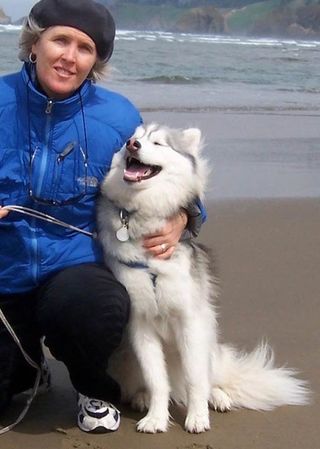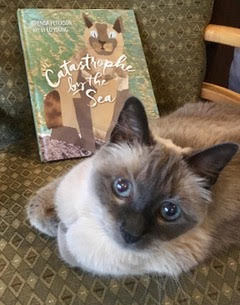Empathy
Kid Lit: Brenda Peterson and 'Catastrophe by the Sea'
Can new stories build ecological empathy to help kids and the planet?
Posted December 16, 2019

Mothering Nature is pleased to welcome children's book author Brenda Peterson. Her latest book, Catastrophe by the Sea, helps signal an important cultural change. She writes for children about animals, the natural world, and how they can take part in building a healthy, thriving world.
Peterson spoke to Mothering Nature about shifting the old-paradigm of control and domination to a new narrative. One grounded in help, support, compassion, collaboration, and the natural interdependence at the heart of the healthy ecosystems we all depend on.
If you are looking for a fun, delightful book to share with a child or grandchild, Catastrophe By the Sea is a wonderful choice. It's a story that's sweet yet compelling, it teaches empathy and compassion through simple modeling, and it accurately depicts the interconnection of life and how even our simplest choices make an instrumental difference.
Our interview follows, but first, watch this wonderful short book trailer for Catastrophe by the Sea.
Thank you so much for joining us, Brenda!

Our interview follows:
Welcome to Mothering Nature, Brenda; it's a pleasure to have you. Can you tell us a little about your background as an author leading up to your most recent book for children, Catastrophe by the Sea? In particular, what ignited you as a writer and nature steward?
I was born in a national forest in the High Sierra mountains, a pristine wilderness with more animals than people. We followed my father’s U.S. Forest Service work throughout my childhood, so forests and wild animals were my mentors and family. Whether I’m writing about gray whales for National Geographic or wolves for my kid’s book, Lobos: A Wolf Family Returns to the Wild, or marine mammals for Wild Orca: The Oldest, Wisest Whale in the World or this new book, Catastrophe by the Sea, I’m always giving back to the natural world—my daily and enduring inspiration.
Can you tell us where the specific idea for Catastrophe by the Sea came from?
The Seattle Aquarium, with whom I’ve long consulted as co-founder of the grassroots naturalist volunteer group, Seal Sitters, asked me to write a children’s book about tidepool creatures with the Caldecott-Award-winning illustrator Ed Young. But how to make these often overlooked and underfoot barnacles or sea anemones fascinating to kids?
My Siamese cat, Loki, often escaped our house to prowl the backyard beach. With his paws, he’d poke sea anemones, who squirted him, as if to say, “We’re alive, too!” A lost cat on the beach who begins as a bully and then befriends Buddy the Barnacle and Naimonee, the beautiful sea anemones, is the story for Catastrophe by the Sea.
How do this book and your others inspire harmony between people and the planet, including non-humans in our ecosystems?
Our new kid’s book is playful, and the vivid collage art is gorgeous; it teaches kids about empathy for even those creatures considered ugly and non-charismatic. Tidepool creatures have superpowers of survival. Every low tide exposes them to the sun, wild surf, and predators. Even the cat is caught up in an undertow.
What do you hope children receive in reading this book and others you've written? Do you hope for action and/or a shift in how people are thinking about our relationship with the natural world?
It is our responsibility as storytellers to not only tell the truth about climate change and ecological collapse but also to give the next generation hope. Stories are tools for us to heal and to imagine better futures for ourselves and other animals. That’s why after writing over 20 books for adults, I’ve spent the last several years writing four children’s books.
Kids also give me hope. They are already very environmentally engaged. When I talk with kids, I ask them to choose their favorite fellow creature and apprentice themselves to learning all they can about that animal; draw and tell stories about their animal; then commit to protecting that animal.
Science and activism begin early with this next generation. One elementary school girl turned her birthday party into a fundraiser for orcas and asked me to sign Wild Orca. Over 50 children attended, and we received over $2,000 for orca research.
Mary Pipher, psychologist and bestselling author (Reviving Ophelia and others), writes in her book, The Green Boat: Reviving Ourselves in Our Capsized Culture:
In our tempestuous times, we can be vibrant, authentic, and emotionally healthy people. In the context of our global storm, the *new healthy normal* requires the ability to move from awareness to action on a regular basis, to maintain a sense of balance, and to live intentionally. It also requires a particular kind of optimism, a connection to a community, and a world-class set of stress-reduction skills. Implied in the term "new healthy normal" is my assumption that it is not mentally healthy to sit idly by while the human race destroys its mother ship...
We can acquire the skills we need to overcome our sense of doom and discover our capacities for transcendent coping.
Could you speak briefly to how your work fits into Pipher's call?
I heartily agree with Mary Pipher’s call to not succumb to environmental doomsaying. Despair is easy and enervating. It requires no imagination and is a dead-end for any optimism. The environmental doom we accept can become a self-fulfilling prophecy.
That’s why stories matter as much as our science. If we tell ourselves and our children a story that imagines other futures than extinction or self-destruction, if we invest in honest science that celebrates other animals and the human ingenuity to adapt—just as those brave, little tidepool creatures face even the most powerful low tides—we and the natural world have a better chance of surviving.
The wonderful art that brings the story to life is from Ed Young.
You can find a little more about the backstory to the collaboration leading to the book at the Seattle Aquarium's debut page.
References
Thank you so much for your work, Brenda, and for visiting Mothering Nature.




